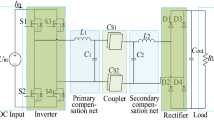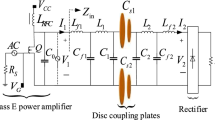Abstract
This paper presents a capacitive power transfer (CPT) system for low power applications. This CPT system utilized π impedance matching to provide reactive compensation and voltage gain, and is driven by a Class-E resonant inverter. In this work, two basic π matching network topologies that can be integrated into the Class-E resonant inverter was analysed. By utilising the proposed method, the zero voltage switching (ZVS) condition can still be achieved even if the load is larger than that optimum and hence yielding high efficiency. Simulation comparison between the two matching networks was performed to determine their performances and later, to select the best matching network that can be integrated into the proposed CPT system prior to practical implementation. The validity of the proposed concept was verified experimentally. A 10 W CPT system lab scale prototype was designed and implemented to demonstrate efficient wireless power transfer across 0.25 mm gap. The experimental work showed that 10 W output power was transferred successfully to the 50 Ω load with only 913 pF capacitive coupling plates at 91.9% efficiency.
Access this chapter
Tax calculation will be finalised at checkout
Purchases are for personal use only
Similar content being viewed by others
References
Marques EG, Mendes AMS (2015) Comparison of magnetic coupling structures for IPT systems. COMPEL 34(2):514–530
Sanni A, Vilches A, Toumazou C (2012) Inductive and ultrasonic multi-tier interface for low-power, deeply implantable medical devices. IEEE Trans Biomed Circuits Syst 6(4):297–308
Nair V, Choi J (2015) An integrated chip high-voltage power receiver for wireless biomedical implants. Energies 8(6):5467–5487
Frey JE, Kreitz A, Scheibe G (2006) Unplugged but connected. EngineerIT 44–45
Choi BH, Nguyen DT, Yoo SJ, Kim JH, Rim CT (2014) A novel source-side monitored capacitive power transfer system for contactless mobile charger using class-E converter. In: 2014 IEEE 79th vehicular technology conference, vol 2015, pp 8–12
Hui SY (2013) Technology for portable electronic products and Qi. Proc IEEE 101(6):1290–1301
Goto K, Nakagawa T, Nakamura O, Kawata S (2001) An implantable power supply with an optically rechargeable lithium battery. IEEE Trans Biomed Eng 48(7):830–833
Deng J, Lu F, Li S, Nguyen TD, Mi C (2014) Development of a high efficiency primary side controlled 7 kW wireless power charger. In: 2014 IEEE international electric vehicle conference (IEVC)
Covic JTBGA (2013) Inductive power transfer. Proc IEEE 101(6):1276–1289
Mi C (2015) Charging applications, no 619, pp 1–35
Huang L, Hu AP, Swain A, Kim S, Ren Y (2013) An overview of capacitively coupled power transfer; A new contactless power transfer solution. In: 2013 IEEE 8th conference on industrial electronics and applications, pp 461–465
Lu F, Zhang H, Hofmann H (2015) A high efficiency 3.3 kW loosely-coupled wireless power transfer system without magnetic material. In: 2015 IEEE energy conversion congress and exposition (ECCE), pp 2282–2286
Li S, Mi CC (2015) Wireless power transfer for electric vehicle applications. IEEE J Emerg Sel Top Power Electron 3(1):4–17
Dai J, Ludois DC (2015) A survey of wireless power transfer and a critical comparison of inductive and capacitive coupling for small gap applications. IEEE Trans Power Electron 30(11):6017–6029
Theodoridis MP (2012) Effective capacitive power transfer. IEEE Trans Power Electron 27(12):4906–4913
Kazmierkowski MP, Moradewicz AJ (2012) Contactless energy transfer (CET) systems—a review. In: 2012 15th international power electronics and motion control conference, pp Session 3–1–Session 3–6
Yusop Y, Saat MSM, Husin SH, Nguang SK, Hindustan I (2017) Performance assessment of class-E inverter for capacitive power transfer system. COMPEL-Int J Comput Math Electr Electron Eng 36(4) ISSN: 0332–1649
Liu C, Hu AP, Budhia M (2010) A generalized coupling model for capacitive power transfer systems. In: IECON 2010—36th annual conference on IEEE Industrial Electronics Society, pp 274–279
Lu F, Zhang H, Hofmann H, Mi C (2016) A CLLC-compensated high power and large air-gap capacitive power transfer system for electric vehicle charging applications. In: 2016 IEEE applied power electronics conference and exposition (APEC), vol 2016, pp 1721–1725
Yusmarnita Y, Saat S, Hamidon AH, Husin H, Jamal N, Kh K, Hindustan I (2015) Design and analysis of 1 MHz Class-E power amplifier 2 circuit description. WSEAS Trans Circuits Syst 14:373–379
Qu X, Zhang W, Wong SC, Tse CK (2015) Design of a current-source-output inductive power transfer LED lighting system. IEEE J Emerg Sel Top Power Electron 3(1):306–314
Author information
Authors and Affiliations
Corresponding author
Editor information
Editors and Affiliations
Rights and permissions
Copyright information
© 2020 Springer Nature Singapore Pte Ltd.
About this paper
Cite this paper
Yusop, Y., Saat, S., Kamarudin, K., Husin, H., Nguang, S.K. (2020). π1a and π1b Impedance Matching for Capacitive Power Transfer System. In: Mohd Razman, M., Mat Jizat, J., Mat Yahya, N., Myung, H., Zainal Abidin, A., Abdul Karim, M. (eds) Embracing Industry 4.0. Lecture Notes in Electrical Engineering, vol 678. Springer, Singapore. https://doi.org/10.1007/978-981-15-6025-5_21
Download citation
DOI: https://doi.org/10.1007/978-981-15-6025-5_21
Published:
Publisher Name: Springer, Singapore
Print ISBN: 978-981-15-6024-8
Online ISBN: 978-981-15-6025-5
eBook Packages: Mathematics and StatisticsMathematics and Statistics (R0)




